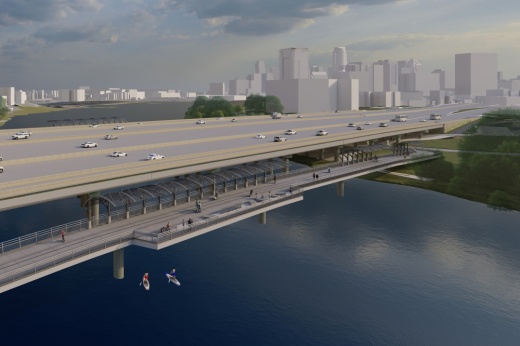A roughly 8-mile stretch of I-35 that runs through downtown Austin is on track to be widened and reconstructed after the Texas Department of Transportation issued its Environmental Impact Statement and record of decision Aug. 21.
“The EIS process is very, very rigorous,” TxDOT Austin District Engineer Tucker Ferguson said. “It’s not just the TxDOT Austin district putting together an analysis. It's reviewed by environmental experts, attorneys, experts outside of TxDOT, in addition to several rounds of public comments we've received over the years in the publication of the draft and individual meetings.”
The documents paved the way for TxDOT to begin construction on the highway in mid-2024. The project will be split into six different phases over the next decade, the first of which will go to bid around March, Ferguson said.
Crews will begin reconstruction of the Lady Bird Lake bridge and the Martin Luther King Jr. Boulevard bridge as well as installation of a drainage tunnel.
A closer look
The documents also revealed several changes TxDOT made after collaborating with Mayor Kirk Watson earlier this summer.
TxDOT will create a construction warning app for drivers to use during the duration of the project and a permanent construction noise barrier for the community garden near Festival Beach. TxDOT is proposing to construct stormwater treatment ponds at the US 183 interchange at Cesar Chavez Street to treat stormwater before discharging to the Colorado River.
TxDOT has also committed an additional $100 million to “aesthetic treatments” along the project with an emphasis on east to west crossings.
About the project
The $4.5 billion project—called I-35 Capital Express Central—will add two high-occupancy vehicle lanes in each direction on the inner sections of the highway and widen the corridor from a range of 11-18 lanes in either direction to 17-22 lanes, when accounting for frontage, bypass and auxiliary roads, according to TxDOT. The plan will also sink the main highway lanes between Airport Boulevard and Lady Bird Lake, and Riverside Drive and Oltorf Street about 25 feet below ground level; remove the upper decks; and widen east-west cross-street bridges.
Zooming out
While TxDOT’s widening plan moves forward, a separate but related plan led by the city to add caps, or large land bridges, and stitches, or bridges, above the sunken roadway remains unfunded.
The caps and stitches project was described by Rep. Sheryl Cole, D-Austin, as the “most monumental part” of the I-35 plan and as a way to ease the divide between east and west Austin.
The city will need to secure funding for the project, which could cost upwards of $800 million, by December 2024 for the cap and stitch project to be realized, according to TxDOT.
The project will need to be funded through multiple sources, including potential funding from The University of Texas, federal grants and land value capture—funds that are generated by the increased property values new projects bring to a city.
Caps and stitches can’t be tacked on to the sunken highway; crews need to build supportive infrastructure for them while they are working on the main project to widen the roadway, according to TxDOT.
“The elimination of the upper decks on I-35 and the lowering of the main lanes from Airport Boulevard to Oltorf Street will have a transformative effect on our community,” Watson said in a statement. “While that’s a positive change to what we have now, there is the opportunity to do even more to realize the full potential of this generational investment by capping large portions of I-35 through downtown. Our challenge now is finding a creative way to pay for it.”
The other side
For years, local leaders, community members and grassroots group Rethink35 have voiced concerns over the I-35 plan as it will displace over 100 businesses and potentially cause negative environmental impacts. Groups have also questioned if the project will actually relieve traffic congestion along the corridor.
“As a heat dome scorches Central Texas in record temperatures, there could be no greater insult than TxDOT announcing its decision to massively expand I-35 through Austin—a project that would divide our city with a heat-trapping asphalt chasm and worsen climate change, making future heat domes hotter and longer,” Rethink35 Board President Adam Greenfield said in a statement.
Rather than widen the highway, community groups have called for the city to invest in public transportation, or turn I-35 into a more pedestrian-friendly boulevard.
“A rapidly growing Austin requires a robust public transportation infrastructure that does not currently exist and that is, unfortunately, not the focus of TxDOT’s current project,” Texas Rep. Gina Hinojosa said in a statement. “For this reason, I join the chorus of involved Austin constituents advocating for greater investment in public transportation as opposed to a widened highway. Notwithstanding, I value the significant time and effort TxDOT has spent listening to our community to improve this project.
Dig deeper
More information on TxDOT’s environmental impact statement and record of decision can be found here.





